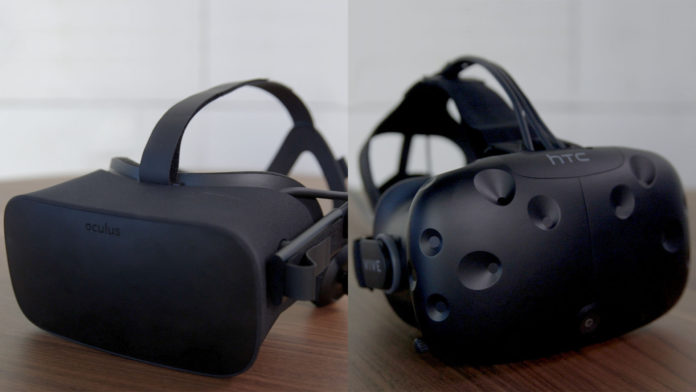One of the challenges you face entering VR is figuring out where your money should go. There are a wealth of great experiences, but which is right for you? There are two setups for serious fitness heads: the Rift and the Vive.
Price Points
Oculus’ Rift headset is an excellent value. At $399, it’s basically half the cost of a Vive. It was also first to hit the market, which makes it one of the largest platforms for development.
Enter Steam, Valve, HTC and the Vive. At $699, the Vive presents a considerable investment in VR as a platform. There’s also the PC you need to build to run it. Here’s why it’s not only worth the cost but worth the effort to jump on board the Vive.
Immersion
 I want to begin by saying that the Rift is immersive and impressive in its own right. It’s also geared to lower technical specs than the Vive, which is why we consider the Rift an entry level VR setup, while the Vive is more luxury.
I want to begin by saying that the Rift is immersive and impressive in its own right. It’s also geared to lower technical specs than the Vive, which is why we consider the Rift an entry level VR setup, while the Vive is more luxury.
Immersion is a big reason why. An upgraded Vive (with improved audio output) feels incredible the first time you put it on. It’s a bit on the heavy side, but resistance isn’t a turn off for fitness. With the proper space, you’re fully immersed in the game. There’s really no other way to explain it, but we’ll try anyway.
The Vive’s refresh rate is 90 Hz, with a full 110-degree field of view and six degrees of freedom. Two screens, with one for each eye and a display output of 1080×1200. You get to do everything short of tasting, touching and smelling the world (and we’re not that far off from at least a few of those). In short, the Vive is incredibly immersive and will only get better.
Tracking and Movement

Nestled inside the Vive are little divots that contain small sensors that assist in positioning you around the room. Sensors you mount to your wall during setup essentially scan your room and find objects you might trip over or run into. A front facing camera allows you to look at the room without removing your headset. Steam VR, the underlying software running Vive, prevents you from moving to certain locations with a blue wall with the chaperone system.
Playing a VR game like Holopoint looks incredible to the visual and auditory senses while activating an adrenaline rush to move in VR. With room to squat and to pivot as you fling arrows off in all directions, there’s little danger of hitting anything around you.
From a technical perspective, this sets the Vive apart from the Rift significantly. The Rift may be friendlier on the wallet, but its system doesn’t allow for one-to-one tracking and room scale immersion on the same level as the Vive. At a fitness level, this means you can’t move and extend your body the way you can with the Vive.
The Vive development teams put a lot of effort into designing a system that allowed for precise motion tracking. Accessories are now available to improve motion tracking and incorporate real-world objects into VR. As a result, the common concern of motion sickness in VR is virtually non-existent in Vive.
Simple and Intuitive Setup and Use
[youtube https://www.youtube.com/watch?v=rv6nVPPDmEI&w=560&h=315]
The fitness aspect of VR is only good if it makes sense to you, and you can setup and use it. Vive has detailed instructional videos that make setup very easy. You will need one USB 3.0 port (these are color-coded blue, typically), and HDMI 1.4 or Display Port 1.2 as the output. That’s in addition to the technical hardware required to run it, but don’t worry about figuring all of that out. Valve has a handy program you can download to check if your PC is Vive ready.
To its credit, Rift does have a similar tool, but with sensors that cannot capture the size of the playing field that Vive can, along with a few accessories that can be added to improve usage. Both the Rift and Vive will go wireless in 2018, with an HTC branded tracking solution being released soon. With a greater range of movement, the Vive will be the clear choice for fitness enthusiasts in this regard.
Final Thoughts
[youtube https://www.youtube.com/watch?v=3OiasdbIlCw&w=560&h=315]
Although choosing between the HTC Vive and Oculus Rift is a difficult one, the Vive becomes the clear winner for fitness purposes. The Vive offers better motion tracking and control over the space around you, with a wider range to move around in and plenty of upgrades in 2018 to offer a better and more immersive experience.
With an expansive game library and a never-ending supply of fitness VR games, it’s no wonder big studios like Bethesda have paired with Valve to launch incredible AAA titles that test the boundaries of VR.



Comments are closed.